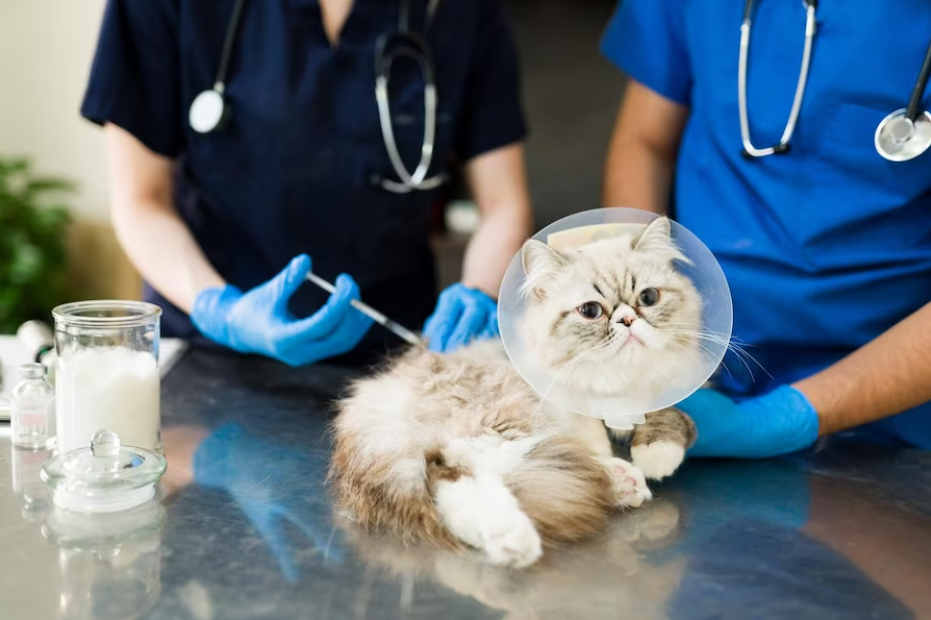Recognizing Signs of Diabetes in Cats and Dogs: What Owners Should Know

As pet owners, our furry friends hold a special place in our hearts. We want nothing more than for them to be happy and healthy. But what happens when they start showing signs of something being wrong? One of the most common health issues affecting cats and dogs is diabetes, which can have serious consequences if left undiagnosed and untreated. As responsible pet owners, it’s important to recognize the signs of diabetes so we can take action early on. In this blog post, we’ll guide you through everything you need to know about recognizing signs of diabetes in your pets, from understanding what causes it to identifying symptoms and managing this condition effectively.
Understanding Diabetes in Pets
Diabetes is a disease that affects pets just as it does humans. It occurs when the body cannot regulate blood sugar levels due to insufficient insulin production or ineffective use of insulin.
There are two types of diabetes in pets, type 1 and type 2. Type 1 is caused by a lack of insulin production while type 2 results from the body’s inability to effectively use insulin.
Both cats and dogs can develop diabetes, but it is more common in older pets, overweight animals, and certain breeds such as Burmese cats and Australian Terriers.
Diabetes can lead to serious health complications if left untreated. High blood sugar levels can damage vital organs like the kidneys, liver, nerves, and eyes. Pets with uncontrolled diabetes may also experience weight loss despite increased appetite.
It’s important for pet owners to understand the signs of diabetes so they can seek veterinary care promptly. Early detection and treatment provide the best chance for managing this chronic condition successfully.
Explanation of diabetes and how it affects cats and dogs
Diabetes is a condition that affects both cats and dogs, just like humans. It occurs when the body fails to produce or properly use insulin, which is responsible for regulating blood sugar levels. Insulin helps glucose (sugar) enter cells where it can be used as energy.
In pets with diabetes, their bodies either don’t produce enough insulin or they cannot effectively utilize it. As a result, the glucose builds up in the bloodstream and causes hyperglycemia (high blood sugar).
Over time, high blood sugar levels can lead to serious health complications such as blindness, kidney disease, nerve damage and even death.
Cats are more prone to developing Type 2 Diabetes while dogs are more likely to develop Type 1 Diabetes. Both types of diabetes require lifelong management through diet control and regular insulin injections administered by pet owners.
It’s important for pet owners to recognize the signs of diabetes early on so that treatment can begin promptly. Regular monitoring of your pet’s behavior and symptoms along with regular vet check-ups can help manage this manageable but life-threatening condition in our furry friends!
Signs and Symptoms of Diabetes in Cats
Cats can be mysterious creatures, and it can sometimes be difficult to tell if they’re experiencing health problems. However, there are a few key signs that pet owners should watch out for when it comes to diabetes in cats.
One of the most common symptoms is increased thirst and urination. Cats with diabetes tend to drink more water than usual, which leads to more frequent trips to the litter box. Additionally, they may experience weight loss despite an increase in appetite.
Another symptom of diabetes in cats is lethargy or weakness. Your normally active cat might seem less interested in playing or interacting with you. You may also notice a decrease in grooming behavior or dullness of their coat.
If left untreated, diabetes can lead to more serious complications such as ketoacidosis or diabetic neuropathy. Therefore, it’s important for pet owners to recognize these early warning signs and seek veterinary care immediately if any symptoms arise.
Detailed list of common symptoms of diabetes in cats
Diabetes in cats is a serious and potentially life-threatening condition that affects their ability to process glucose. Early identification of symptoms can help pet owners take the necessary steps to manage their cat’s health and prevent long-term complications.
One of the most common symptoms of diabetes in cats is increased thirst, which can lead to more frequent urination. Cats suffering from diabetes may also experience weight loss despite an increase in appetite, as well as lethargy and weakness.
Other signs include changes in coat quality or texture, such as dandruff or matting, along with decreased grooming habits. Some diabetic cats may have trouble jumping up onto surfaces they could previously reach without difficulty.
In addition to these physical symptoms, behavioral changes are also often observed in cats with diabetes. These can include irritability or aggression, depression, hiding away from family members or other pets, and reduced interest in playtime activities.
Pet owners should be aware that not all diabetic cats will display all these symptoms at once; some may exhibit only one or two early on before others become noticeable over time. Any concerns about potential signs of diabetes should always prompt consultation with a veterinarian for proper evaluation and treatment options.
How these symptoms may manifest in everyday behavior
Recognizing the symptoms of diabetes in pets can be challenging, especially since they may not always show obvious physical signs. However, understanding how these symptoms manifest in everyday behavior can help pet owners identify potential health issues early on.
In cats, an increased appetite accompanied by weight loss is a common symptom of diabetes. Owners may notice their feline friend becoming more vocal or demanding for food despite being fed regularly. Additionally, cats with diabetes may drink more water and urinate frequently.
On the other hand, dogs with diabetes tend to become lethargic and less active than usual. They might also experience sudden weight loss or gain without any changes in diet or exercise routine. Pet owners should look out for excessive thirst and frequent urination as well.
Aside from physical manifestations, changes in behavior could also indicate possible health concerns related to pet diabetes. For instance, both cats and dogs may display decreased energy levels or seem less interested in playing or going for walks.
It’s important to note that these behaviors alone do not necessarily mean your pet has diabetes but are worth bringing up with your veterinarian during regular check-ups. By staying vigilant and familiarizing yourself with your furry companion’s normal habits and routines, you’ll be better equipped to recognize subtle warning signs of potential health problems before they escalate into serious conditions like pet diabetes.
Signs and Symptoms of Diabetes in Dogs
Diabetes is a serious condition that can affect dogs of any age, breed or gender. As with cats, diabetes causes elevated blood sugar levels in dogs due to insufficient insulin production or resistance to the hormone. Early diagnosis and treatment are crucial in managing diabetes in dogs and preventing complications.
One common sign of diabetes in dogs is increased thirst and urination. If your dog seems to be drinking more water than usual and needs to go outside frequently to urinate, it may indicate an underlying health issue like diabetes.
Another symptom of canine diabetes is weight loss despite an increase in appetite. Dogs with untreated diabetes cannot properly convert food into energy, leading them to lose weight despite consuming more calories than usual.
In addition, diabetic dogs may experience lethargy or weakness as their bodies struggle to use glucose for energy effectively. They may also have poor skin and coat health due to dehydration caused by excessive urination.
Other signs of canine diabetes include vomiting, diarrhea, cloudy eyes (due to cataracts), slow-healing wounds, and even seizures if left untreated for long periods.
If you notice these symptoms in your furry friend, it’s essential not only to seek veterinary care immediately but also make necessary changes such as dietary modifications under the guidance of a veterinarian.
Detailed list of common symptoms of diabetes in dogs
Diabetes in dogs is a common health problem that affects their ability to regulate blood sugar levels. This can lead to several symptoms that pet owners should watch out for.
Increased thirst and urination are two of the most commonly observed signs of diabetes in dogs. If your dog suddenly starts drinking more water than usual or needs to go outside more frequently, it could be a sign of diabetes.
Another symptom is weight loss despite an increased appetite. This happens because the body cannot use glucose properly, so it starts breaking down fat stores instead.
Lethargy and weakness are also common signs of diabetes in dogs. Your furry friend may seem less energetic than usual or have difficulty walking due to muscle wasting.
Other potential indicators include cloudiness or cataracts in the eyes, infections that take longer to heal, and even vomiting or diarrhea.
If your dog exhibits any of these symptoms, it’s important to consult with your veterinarian as soon as possible. Early detection and treatment can make all the difference when managing diabetes in pets.
How these symptoms may manifest in everyday behavior
Diabetes can affect both cats and dogs, and it’s important for pet owners to be able to recognize the signs of this condition. One way that diabetes may manifest in everyday behavior is through changes in appetite. Pets with diabetes may start eating more or less than usual, and they may also have an increased thirst.
Another symptom of diabetes that pet owners should watch out for is changes in weight. Cats or dogs with this condition might lose weight even if they are eating more food than usual. Alternatively, they may gain weight despite being on a strict diet.
In addition to changes related to appetite and weight, pets with diabetes may also become lethargic or uninterested in physical activity. This could mean that your cat doesn’t want to play as much as she used to, or your dog seems less enthusiastic about going on walks.
Some pets with diabetes may experience urinary tract infections (UTIs) or other issues related to urination. If you notice any unusual behaviors when your pet goes outside or uses their litter box, such as straining during urination or frequent accidents inside the house, it could be a sign of diabetes.
Recognizing these symptoms can help pet owners take action early so they can get their furry friends the treatment they need before things escalate further.
What to Do If You Notice Signs of Diabetes
If you notice any signs of diabetes in your cat or dog, it’s important to take action right away. The earlier the diagnosis and treatment, the better the chances of managing this condition.
The first step is to schedule an appointment with your veterinarian. They will perform a physical examination, blood work, and urinalysis to confirm if your pet has diabetes. If diagnosed positively for diabetes, ask for guidance on how to manage their diet and exercise routine at home.
Your veterinarian may recommend insulin injections or other medications as part of their treatment plan. It’s important that they receive medication on time daily as prescribed by the vet.
Additionally, monitoring glucose levels at home can help you track progress and identify any changes that need immediate attention.
Remember that early detection is key when it comes to managing pet diabetes. So stay aware of potential symptoms and always consult with a professional if you suspect something might be wrong with your furry friend’s health!
Importance of immediate veterinary consultation
If you notice any signs of diabetes in your cat or dog, it is crucial to seek veterinary consultation as soon as possible. Diabetes can cause serious health complications if left untreated.
A veterinarian will perform a physical examination and may conduct blood tests to diagnose diabetes. They will also determine the severity of the condition and develop a treatment plan tailored to your pet’s needs.
Immediate veterinary attention can help prevent further damage to their health, including vision loss and nerve damage. It can also prevent more severe symptoms from developing, such as kidney failure or coma.
Early detection and management are key factors in successfully treating diabetes in pets. By working with a veterinarian, pet owners can take proactive steps to manage their pet’s condition and improve their quality of life.
Remember that regular check-ups with your vet are important for maintaining your pet’s overall health. Don’t hesitate to consult with them if you suspect something is wrong – prompt action could save your furry friend’s life!
Managing Diabetes in Cats and Dogs
Managing diabetes in cats and dogs can be a challenging task, but it is essential for maintaining their overall health. The key to managing pet diabetes effectively lies in developing a comprehensive treatment plan with your veterinarian. This plan may include dietary changes, exercise routines, medication regimens, and regular check-ups.
One of the most important aspects of managing pet diabetes is monitoring blood glucose levels regularly. This involves performing at-home testing or bringing your pet to the vet for blood tests as recommended by your veterinarian. It’s also crucial to ensure that medications are given on time and according to dosage instructions provided by the vet.
Dietary changes play an integral role in managing feline and canine diabetes. Feeding pets with diabetic-friendly food helps regulate their blood sugar levels while ensuring they receive all necessary nutrients. A low-carbohydrate diet may be recommended by veterinarians as well as portion control based on weight management goals.
Exercise is another critical aspect of keeping pets healthy when dealing with diabetes; daily walks or active playtime sessions can help maintain weight loss goals while regulating insulin sensitivity.
Remember always work closely with your veterinarian when developing a comprehensive treatment plan for managing pet diabetes; this will allow you to give them the best quality of life possible!
Conclusion
Recognizing the signs of diabetes in cats and dogs is crucial for pet owners to ensure their pets receive the necessary care and treatment. Regular veterinary check-ups and monitoring can help detect any early signs of diabetes, leading to better management and improved quality of life for our furry friends.
It is essential to understand that diabetes in pets is a manageable condition with proper medical attention, diet, and exercise. With the right measures taken by pet owners, diabetic pets can live healthy lives just like any other animal.
By staying vigilant about your pet’s health, you play an active role in preventing or managing diseases such as diabetes. Always remember that early detection leads to early intervention – so take note of the symptoms discussed above if you suspect your cat or dog may have developed this disease.
If you notice any changes in behavior or unusual symptoms that cause concern for your beloved pets’ health, don’t hesitate to contact a veterinarian immediately. Your pet’s well-being depends on it!



